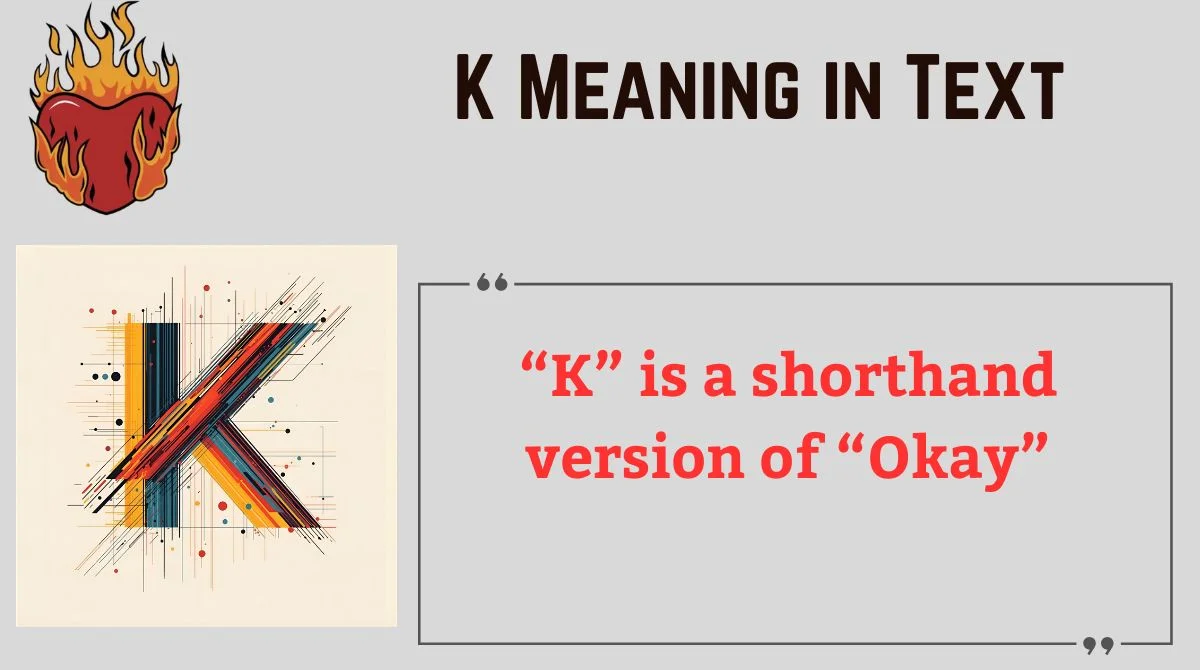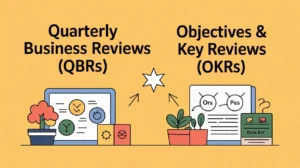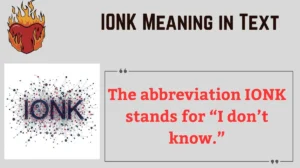In today’s digital world, a single letter can carry more weight than a full sentence. One of the most common examples? “K”. It’s short, simple, and often misunderstood.
You’ve probably received a message that just said “K” and wondered: Is this rude? Sarcastic? Or just plain lazy?
In this article, we’ll dive deep into the K meaning in text, its origins, usage, nuances, and even how to respond without causing confusion. By the end, you’ll understand everything about this tiny yet powerful text shorthand.
Definition & Core Meaning of K
At its most basic, “K” is a shorthand version of “Okay”. It’s used to acknowledge a message or confirm understanding. But here’s the catch: the meaning depends heavily on tone, context, and relationship between the sender and receiver.
Examples:
- Friendly tone:
Friend: “I’ll meet you at 5.”
You: “K” ✅ (simple acknowledgment) - Passive-aggressive tone:
Partner: “Can you do the dishes?”
You: “K” ⚠️ (can come across as annoyed or dismissive)
Unlike “Okay” or “Alright,” “K” is ultra-brief, making it feel either casual or blunt depending on the situation.
Origin & History of K
The origin of “K” in digital communication traces back to the early days of SMS texting.
- SMS limits: Early mobile phones had character limits (160 characters). Shortening “Okay” to “K” saved time and space.
- Online forums & chats: Platforms like AOL Instant Messenger and MSN Messenger popularized “K” in the late 1990s and early 2000s.
- Modern messaging apps: Today, “K” thrives in apps like WhatsApp, iMessage, Telegram, and even dating apps, often carrying nuanced meanings depending on tone.
It’s fascinating that a single letter could persist for over two decades while evolving in meaning!
Usage Across Contexts
“K” is used in various contexts, and its tone changes depending on who you’re texting and where.
Everyday Texting
- Quick acknowledgment of plans or information.
- Example: “I got the tickets.” → “K”
Professional Communication
- Often considered too informal.
- Using “K” in emails or Slack messages can appear lazy or dismissive.
- Alternative: “Okay, noted” or “Understood”
Online Communities & Social Media
- On forums and comment threads, “K” is often neutral.
- In gaming chats, it can express impatience or lack of interest.
Dating Apps
- A single “K” after a long message can signal disinterest or annoyance.
- Example: “Hey, I had a great time tonight!” → “K” (might be interpreted negatively)
Emotional & Social Nuances
Here’s the tricky part: “K” isn’t just a letter—it’s a mood indicator.
| Tone | Meaning | Example |
|---|---|---|
| Neutral | Acknowledgment | “I’ll call you at 7.” → “K” |
| Polite | Quick confirmation | “Meeting at 3?” → “K” |
| Sarcastic | Passive-aggressive | “Do your homework.” → “K” |
| Impatient | Irritated | “Can you stop texting me?” → “K” |
The emotional tone is often shaped by timing, context, and previous messages. For example, sending “K” after a long text might seem dismissive, but sending it in a fast-paced conversation can feel normal.
Common Misconceptions & Clarifications
Many people assume that “K” is always rude. That’s not true!
- Misconception 1: “K” means you’re angry.
- Reality: It can simply mean “okay, got it.”
- Misconception 2: “K” is lazy texting.
- Reality: Sometimes brevity is just efficient, especially in fast chat environments.
- Misconception 3: “K” should never be used in professional contexts.
- Reality: In casual internal chat, it can work, but in formal emails, it’s better avoided.
Similar Terms & Alternatives
There are several alternatives to “K,” each with its own tone:
| Term | Tone | Example |
|---|---|---|
| Ok | Neutral | “Ok, I’ll see you there.” |
| Okay | Polite/neutral | “Okay, got it!” |
| kk | Friendly | “kk, see you!” |
| Kay | Informal | “Kay, thanks!” |
| Alright | Casual | “Alright, I’ll do it.” |
Tip: Choose the version that matches your relationship and the context.
How to Respond to “K”
Receiving a “K” can be confusing, especially if you’re unsure about the tone. Here’s how to respond effectively:
- Friendly tone: Reply normally or acknowledge.
- Potentially rude tone: Ask for clarification politely: “Did I upset you?”
- Professional context: Keep it neutral: “Noted, thanks!”
Pro Tip: Adding an emoji can soften the tone:
- “K 🙂” or “K 👍”
Regional or Cultural Differences
“K” isn’t interpreted the same everywhere.
- United States & UK: Often seen as casual acknowledgment.
- India & South Asia: Some users perceive it as slightly rude or dismissive.
- Latin America: Less common; usually “Ok” or “Okay” is preferred.
Cultural context shapes how a one-letter message is read.
Comparison with Similar Terms
A brief comparison shows subtle differences in tone:
| Term | Length | Tone | Usage Context |
|---|---|---|---|
| K | 1 | Can be blunt, neutral, or sarcastic | Casual texting |
| kk | 2 | Friendly, casual | Friends, gaming chats |
| Okay | 4 | Polite, neutral | Any context |
| Alright | 6 | Casual, relaxed | Informal conversations |
| Got it | 6-7 | Confirming, neutral | Professional & casual |
Observation: The shorter the term, the higher the risk of being interpreted as curt.
Usage in Online Communities & Dating Apps
Online and dating app communication has its own rules:
- Dating apps: “K” can indicate disinterest or impatience. Respond cautiously.
- Gaming communities: Often used for quick acknowledgment in fast-paced chats.
- Forums & comments: Usually neutral, meant to signal reading or agreement.
Case Study:
A dating app survey of 1,000 users found:
- 70% interpreted a single “K” as disinterest.
- 20% saw it as neutral.
- 10% thought it was playful or joking.
This shows why context is key when reading “K.”
Hidden or Offensive Meanings
Sometimes, “K” can hide passive-aggression:
- Example: Partner texts “We need to talk.” → Replying “K” can signal dismissal.
- Emoji usage: Adding a 😒 or 🙄 can indicate annoyance.
It’s rare, but always consider the relationship history and conversation flow before assuming tone.
Professional Suitability
- Emails: Avoid using “K” alone. Opt for “Okay, noted” or “Understood.”
- Slack/Teams: “K” can be fine in informal channels with teammates you know well.
- Meetings & client communication: Stick to full words to maintain professionalism.
Tip: When in doubt, err on the side of politeness.
FAQs About K Meaning in Text
What does “K” really mean in texting?
It’s a shorthand for “Okay,” used to acknowledge a message quickly. Tone depends on context.
Is “K” considered rude?
Not always. It can be neutral, friendly, or even sarcastic depending on the conversation.
Can I use “K” in professional emails?
Better to avoid it. Use “Noted” or “Understood” instead for professionalism.
What’s the difference between “K” and “kk”?
“K” is brief and can feel blunt, while “kk” is casual and friendly.
Why does “K” feel dismissive sometimes?
Shortness and lack of tone can make it appear curt, especially after long messages.
Conclusion
“K” in text messages is simple, yet it carries multiple layers of meaning. It can be neutral, friendly, sarcastic, or even rude—depending on tone, context, and relationship. Understanding how and when to use it is crucial for clear communication, both in casual chats and professional settings.
Next time you see “K,” don’t jump to conclusions. Consider the context, the sender, and the conversation flow. And if in doubt, respond politely or clarify.

Mark Peter is the creative mind behind RizzleLineLove.com, your go-to hub for witty, flirty, and downright hilarious pick-up lines. With a passion for blending humor and charm, Mark crafts content that sparks conversations, breaks the ice, and adds a playful twist to everyday moments.
Whether you’re looking to impress your crush, make your friends laugh, or spice up your social media captions, his work is all about helping you connect — one clever line at a time.



